
In today’s fiercely competitive marketplace, staying ahead of the game on Amazon is no easy feat.
With millions of sellers competing for the attention of millions of shoppers, it can be tough to cut through the noise and make a lasting impression.
That’s why conducting a thorough competitor analysis has become an absolute must for any brand or seller looking to succeed in the world’s largest online marketplace.
Whether you’re a seasoned Amazon seller or just starting, the benefits of conducting a competitor analysis are clear.
By leveraging market data and staying abreast of your rivals’ strengths and weaknesses, you can fine-tune your approach, grow your sales, and ultimately come out on top.

If you’re looking to take your Amazon business to the next level, conducting a thorough competitor analysis is crucial.
This means taking a deep dive into the products in direct competition with your own offerings on the platform,
understanding their unique features and benefits, and identifying areas where you can differentiate and improve your product positioning.

When it comes to e-commerce, Amazon is a battlefield where the competition is fierce and unrelenting.
Your product is constantly being pitted against others, whether it’s on the search results page, product detail pages, or even in advertising placements.
It’s a dog-eat-dog world out there, and it’s rare for a shopper to come across your product without any rivals.
Of course, there is one place where your product can enjoy some respite from the competition: the Brand Store.
However, even this oasis of exclusivity is short-lived, as shoppers are eventually directed to product detail pages..
Where they are once again confronted with a sea of competing products.
In other words, the struggle for visibility and sales is never-ending on Amazon.
To thrive in this cutthroat environment, you must stay ahead of the game and ensure your product stands out from the rest.
For Example:
Let’s say you’re a seller of skin care products, and your organic rankings are quite high, but you’re not yet the best seller.
If the best seller runs out of stock, you can expect to see a surge in sales without lifting a finger.
Conversely, if the best seller starts advertising on your product detail page, you might experience a drop in revenue, even if you’ve done nothing to provoke it.
To win in today’s business landscape, advertisers must:
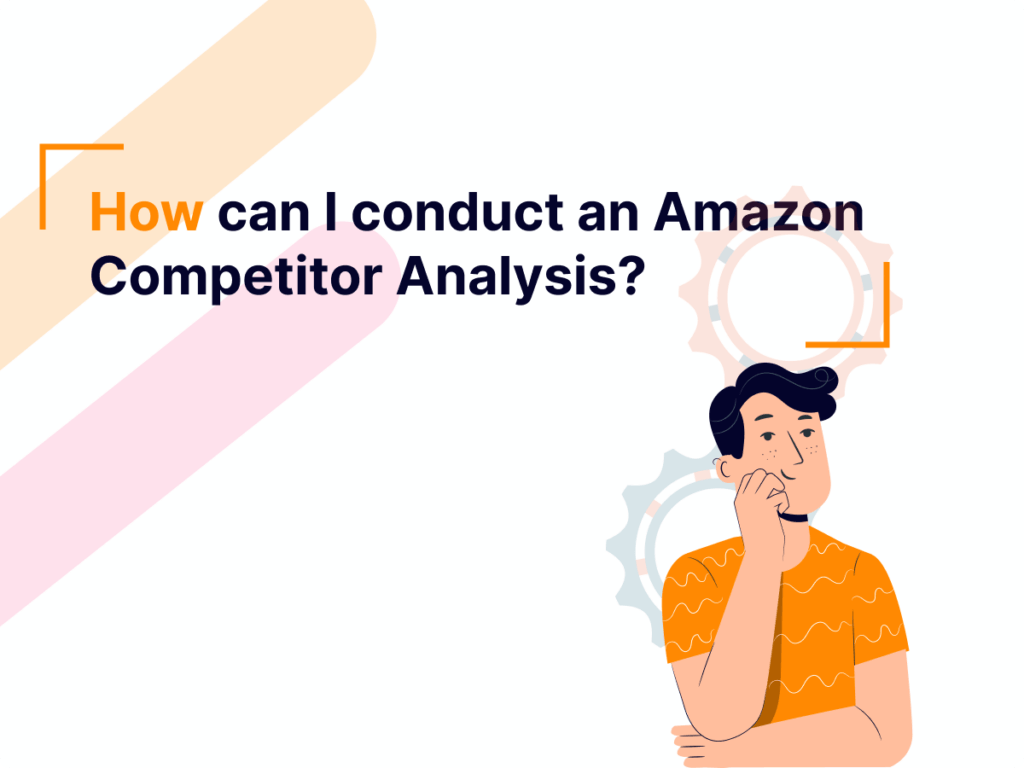
To perform an Amazon competitor analysis, the first step is to clearly define your market.
Although it may seem simple, this process demands a deep comprehension of your industry and product, as well as careful and thorough deliberation.
Doing so can you set the foundation for a successful analysis.

Targeting the “right market” is crucial for high sales and attracting the right customers.
This means identifying a group of ASINs that generate significant sales and align with your product’s shopper intent.

To succeed on Amazon, it’s vital to identify your direct competitors. But only some sellers offering a similar product are a direct competitor.
To pinpoint your direct competitors, keep the following factors in mind:
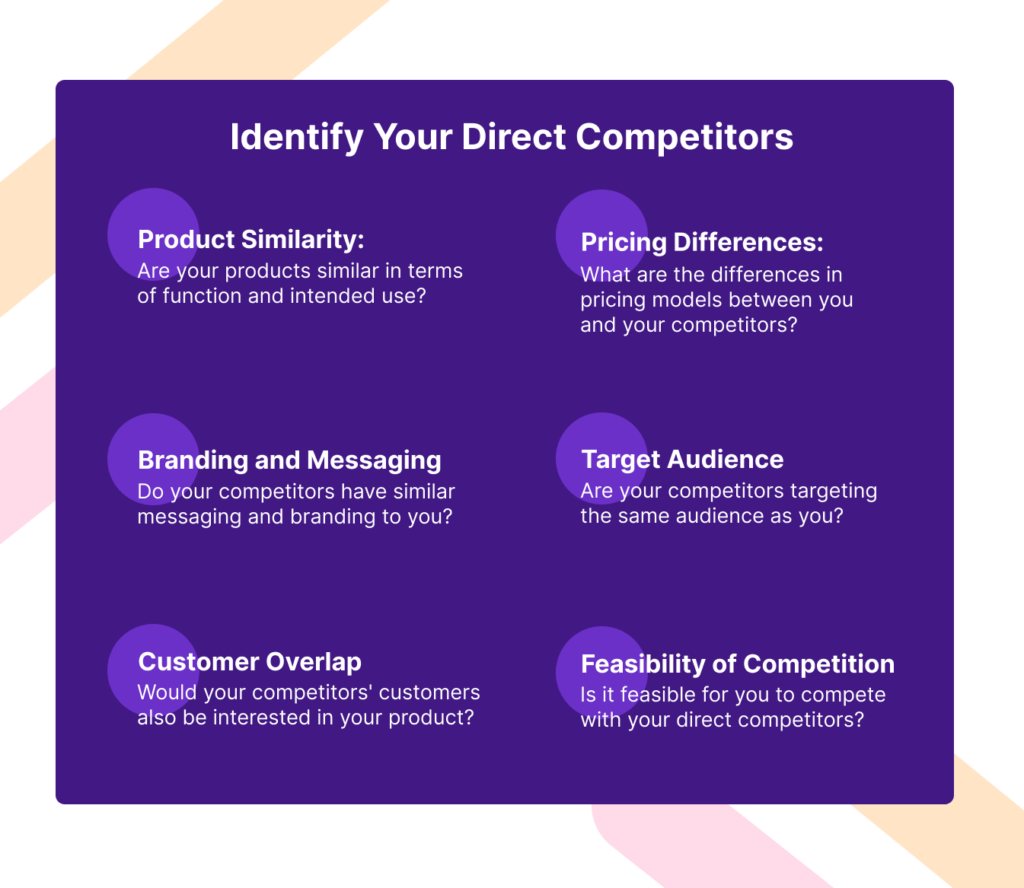
Your direct competitors are those with overlapping products, pricing, messaging, and target audience.
By identifying them, you can better understand the market and make informed decisions to stay competitive.
For Example,
Nike and Adidas are direct competitors because they both offer athletic footwear and apparel.
However, neither of them is a direct competitor to a luxury fashion brand like Louis Vuitton.
While some consumers may consider purchasing Nike and Louis Vuitton products, the messaging, branding, target audience, and pricing models differ for both brands.
Therefore, Nike and Louis Vuitton have different direct competitors in the market.
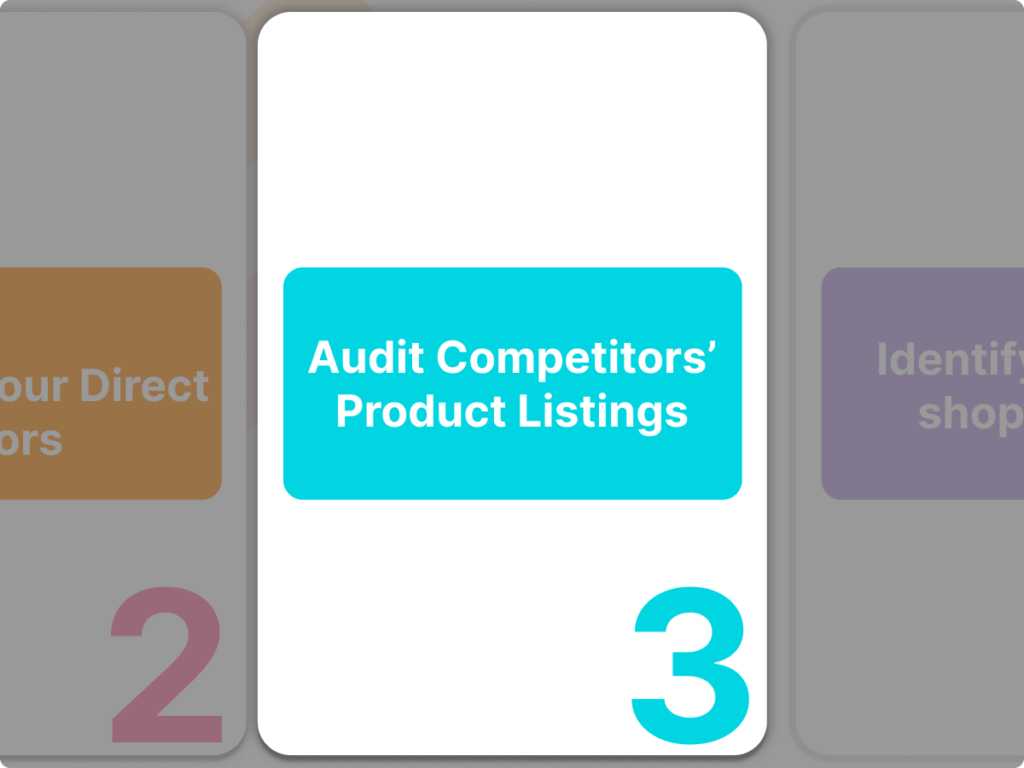
To gain a competitive edge, identifying your direct competitors is just the beginning.
Analyzing their Amazon product listings from a customer’s perspective is key.
Compile a list of their products, dive into each element of their listings..
And take note of their titles, descriptions, features, pricing, images, reviews, and ratings.
By doing so, you can
This knowledge will help you dominate your market and build a successful business.
When browsing search results, customers tend to focus on two key elements: the product title and the image.
To optimize your product listing, consider the following:
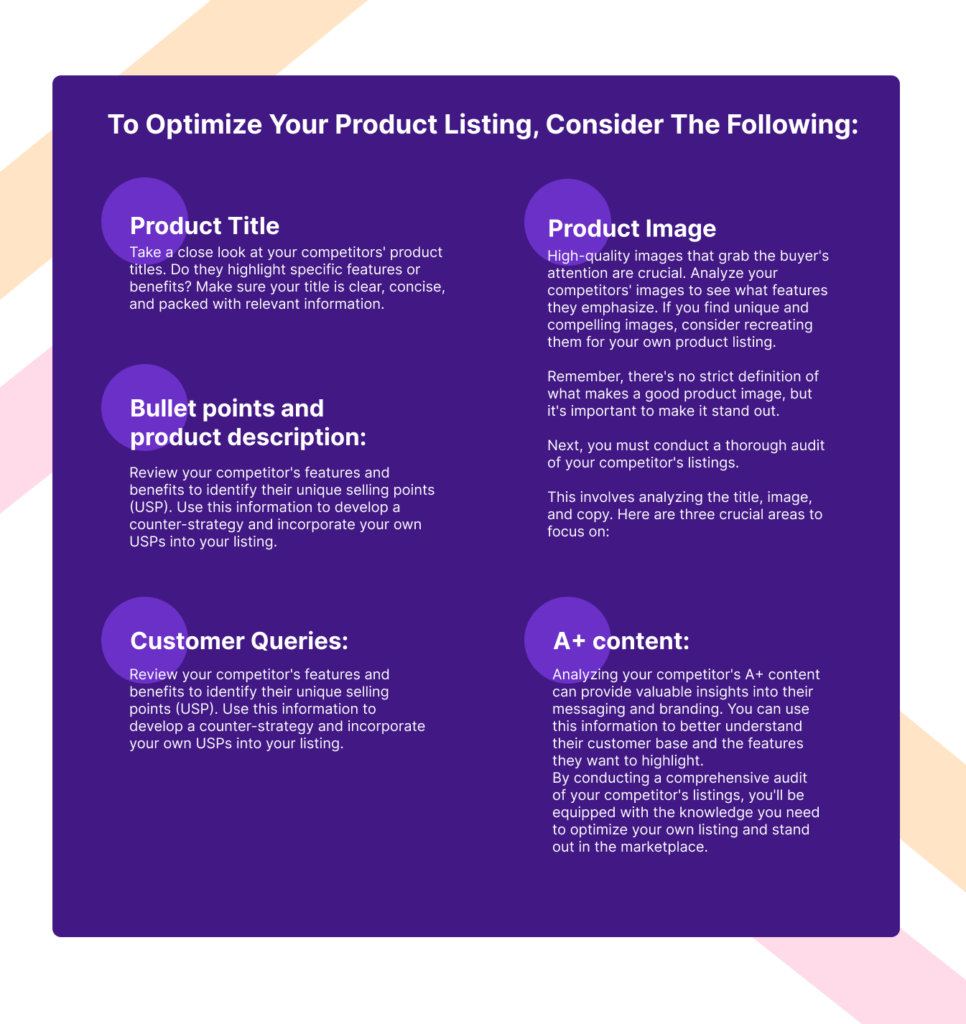
Product Title: Take a close look at your competitors’ product titles. Do they highlight specific features or benefits?
Make sure your title is clear, concise, and packed with relevant information.
Product Image: High-quality images that grab the buyer’s attention are crucial.
Analyze your competitors’ images to see what features they emphasize. If you find unique and compelling images, consider recreating them for your own product listing.
Remember, there’s no strict definition of what makes a good product image, but it’s important to make it stand out.
Next, you must conduct a thorough audit of your competitor’s listings.
This involves analyzing the title, image, and copy.Here are three crucial areas to focus on:
Bullet points and product description: Review your competitor’s features and benefits to identify their unique selling points (USP).
Use this information to develop a counter-strategy and incorporate your own USPs into your listing.
Customer Queries: Pay attention to the questions raised by customers in this section.
This will help you understand what shoppers look for in your product and allow you to optimize your bullet points and product description accordingly.
A+ content: Analyzing your competitor’s A+ content can provide valuable insights into their messaging and branding.
You can use this information to better understand their customer base and the features they want to highlight.
By conducting a comprehensive audit of your competitor’s listings, you’ll be equipped with the knowledge you need to optimize your own listing and stand out in the marketplace.
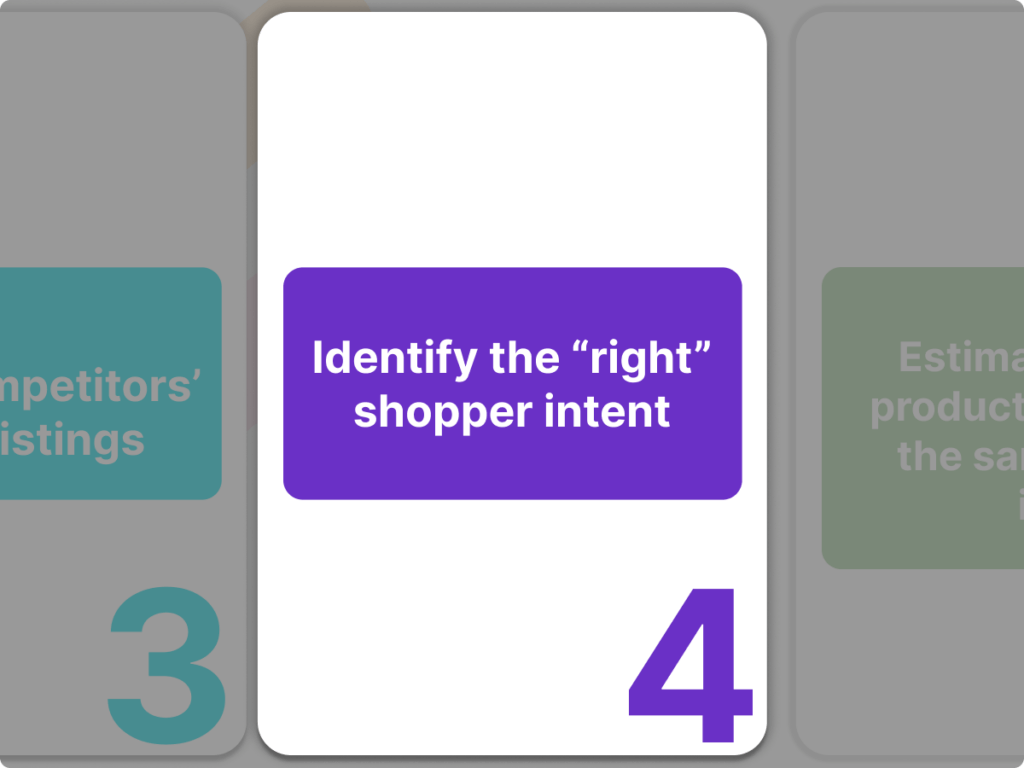
When looking for competitor products that align with your target shopper’s intent, the usual method is to categorize products by their ASINs.
Unfortunately, this approach comes with some challenges.
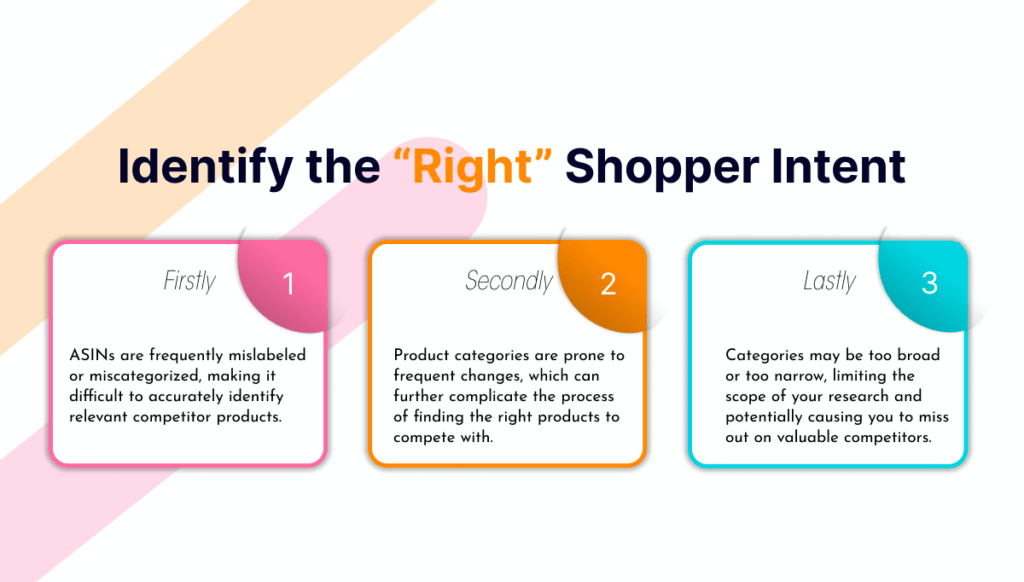
Therefore, taking a more strategic and nuanced approach is crucial when identifying competitor products.
Our suggested approach involves identifying ASINs based on keyword rankings and/or product titles.
The reason behind this strategy is that shoppers express their needs clearly in their search queries.
Amazon has made significant investments in developing an algorithm that meets these needs.
Thus, this approach can help improve your Amazon presence and better connect you with potential customers.
When multiple ASINs appear in search results for a specific term, customers purchase those products after searching for that term.
This typically indicates that these ASINs fulfill a similar need for the customer.
So, if you want to increase your chances of being included in those search results, it’s important to make sure your product meets the same need and is optimized for those relevant search terms.
If you’re looking for a simple and efficient way to find ASINs that rank for the same search terms, follow these steps:
You now have a list of relevant competitors at your disposal.
Keep in mind that this method provides you with the top three ASINs for each search term in the Amazon Search Term report.
However, getting a general idea of your competitors is a great starting point.
For more in-depth analysis, you’ll need to use an Amazon competitor analysis tool.
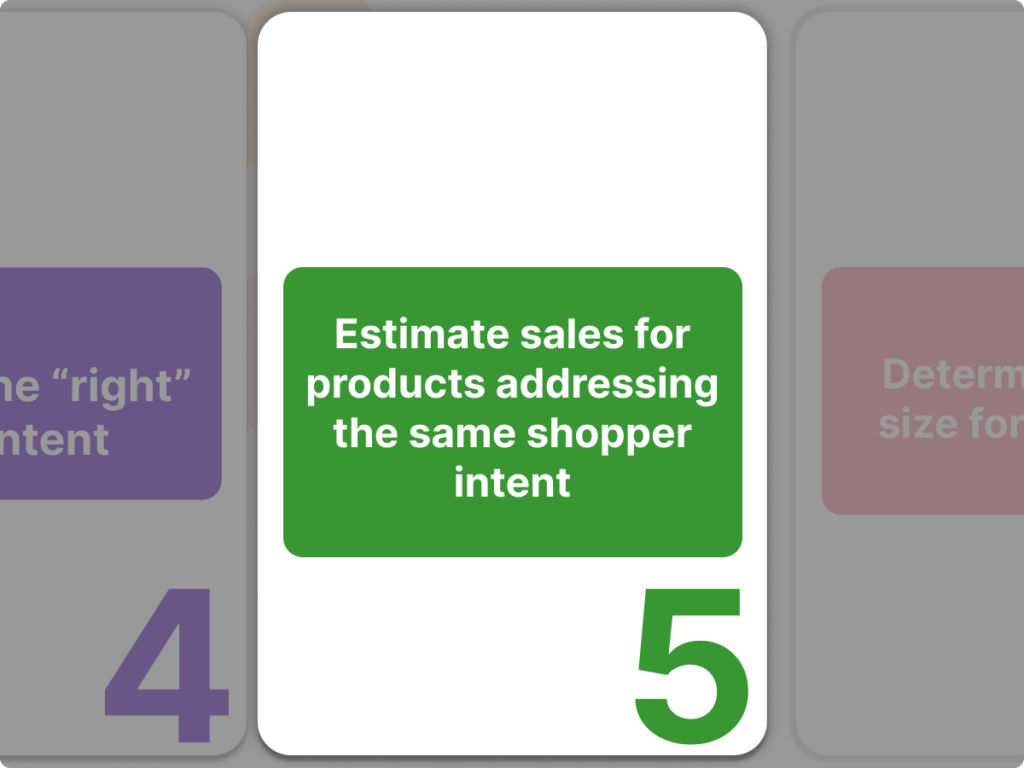
If you want to estimate the sales of your competitor’s products, a useful method is to compare their sales data with the best seller rank (BSR) of your own products.
By plotting these metrics and analyzing the trendline, you can gain insight into how well or poorly your competitors’ products are selling.
However, keep in mind that this technique is only effective for products within the same category or subcategory.
So, make sure to use this approach appropriately to gain an advantage in the market.
If you’re new to BSR, here’s a brief overview.
Amazon assigns a “Best Seller Rank” (BSR) to each ASIN.
This rank is determined by the number of units sold within a particular time frame and product category.
Essentially, the BSR creates a hierarchy of ASINs within each category..
with the best-selling ASIN, assigned a rank of 1, the second-best-selling ASIN assigned a rank of 2, and so on.
Knowing the exact sales volume of competitor products can be challenging due to several complex factors.
For instance, how do you consider the updated Best Sellers Rank (BSR), the weight of historical sales, and the presence of multiple sellers for the same ASIN?
Additionally, distinguishing between an ASIN, that’s out of stock and one that’s losing popularity can be tricky.
Fortunately, an Amazon competitor analysis tool can help you tackle these complexities and provide more accurate sales data.
So, investing in a reliable analysis tool is a smart move if you want to gain a competitive edge.

Once you’ve completed your Amazon competitor analysis, it’s crucial to determine the appropriate market size.
Brands commonly establish two types of markets: one for tactical decision-making and one for strategic analysis.
By doing so, you’ll have a better understanding of your market and be able to make informed decisions for your business.
Don’t overlook this crucial step in your analysis process.

To make smart tactical decisions, you should focus on analyzing the top 5-20 competitors in your industry.
Including too many competitors can lead to noisy data that contradict each other..
Making it hard for you to make sense of the information and take action accordingly.
So, keep it simple and concentrate on a select few to gain valuable insights.
To conduct a thorough strategic analysis, it’s important to consider all relevant competitors.
However, executing these analyses can be tough if you don’t have the expertise in advanced data analysis.
That’s where an Amazon competitive intelligence tool can make a big difference in simplifying the process.
To make progress with your Amazon business, it’s important to know what your competitors are doing.
By checking out their sales and marketing strategies, you can better understand what you’re up against and improve your approach.
Not keeping an eye on your competition can make it tough to succeed on Amazon.
So, do your homework on your rivals and use what you learn to do better and stand out from the crowd.